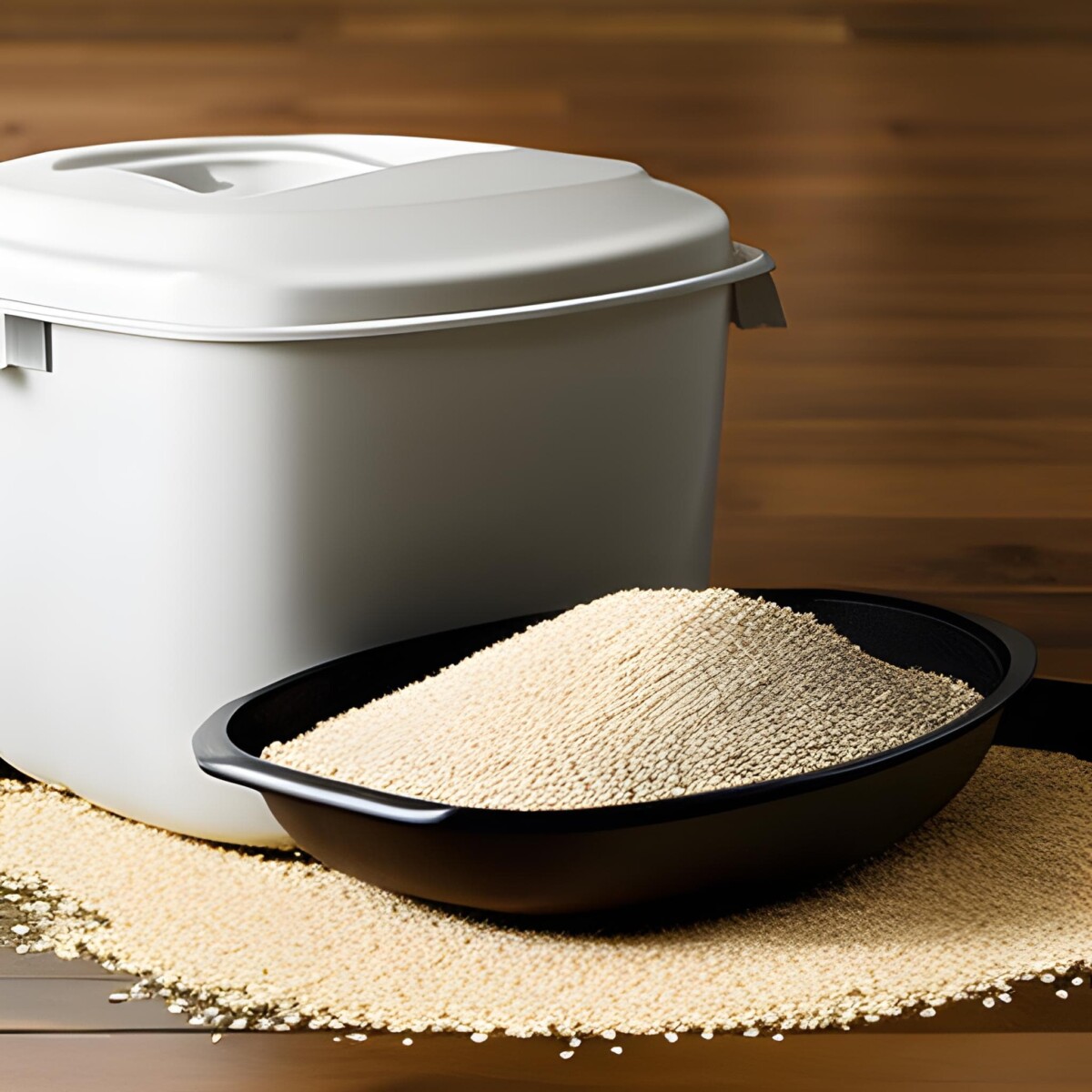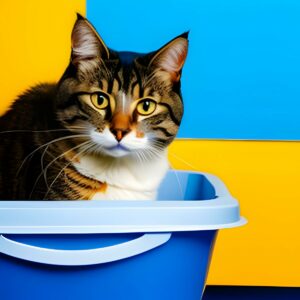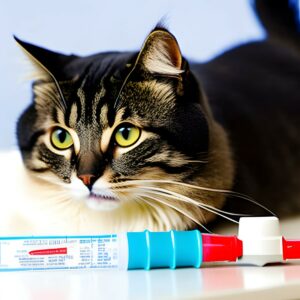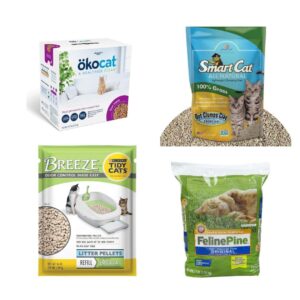Cats develop preferences for kitty litter substrate. Some cats don’t mind the litter type change, while others can become stressed out and start avoiding the litter box altogether.
Around 10% of cats will develop some issues with using the litter box.
Cats with UTI and other health issues can connect pain to the litter box.
Senior cats may start urinating outside the box.
Cats can also have issues with the type of cat litter you are using. Strong scent and texture particularly play a role here.
Cat litter is crucial for your cat’s overall health so let’s talk about different types of cat litter, and their pros and cons.
What different types of cat litter are there?
| Types of cat litter | Pros | Cons | Best product |
| Clumping Clay Litter | Clumping Ability Easy Scooping Odor Control Less Litter Waste Availability | Dust Tracking Clay Mining Clay Ingredients | View |
| Non-Clumping Clay Litter | Odor Control Absorbency Cost-Effective | Cleaning Difficulty DustTracking Environmental Impact Weight | View |
| Silica Crystals Litter | Absorbency Odor Control Low Dust Long Lasting Lightweight | Stirring Required Price Litter Tracking Poo Odor Coverage Premature Breakdown | View |
| Dust-Free Litter | Reduced Dust Respiratory Health Easy Cleanup Cat Comfort | Limited Options Clumping Ability CostTracking | View |
| Non-Tracking Litter | Reduced Mess Easy Cleanup Improved Air Quality Cat Comfort | Limited Options Clumping Ability Price Tracking Reduction Not Elimination | View |
| Pine-Based Cat Litter | Non-Toxic and Natural: Eco-Friendly Odor Control Low Dust Gentle on Cat’s Paws | Tracking Less Effective for Feces Odor Transition Challenges Availability and Cost Strong scent | View |
| Tofu-Based Cat Litter | Eco-Friendly Biodegradable Absorbency Low Dust Natural Material | Availability Tracking Price Transition Challenges | View |
| Paper-Based Cat Litter | Eco-Friendly Low Tracking Dust-Free Absorbency Variety of Types and Textures | Odor Control CostAvailability Cat Preference | View |
| Corn-Based Cat Litter | Natural and Biodegradable Low Dust Good Odor Control Clumping Ability Flushable | Tracking Attraction to Bugs Potential Aflatoxin Contamination Price | View |
| Wheat-Based Cat Litter | Natural and Biodegradable Low Dust Clumping Ability Odor Control Flushable | Tracking Attraction to Bugs Potential Allergies Price | View |
| Walnut Shell-Based Cat Litter | Environmentally Friendly Odor Control Virtually Dust-Free Gentle on Cat’s Paws Clumping Ability | Potential Allergies Tracking Availability | View |
Types of Cat Litter: Table of Contents
Clumping Clay Litter
This type of litter, made from bentonite clay, forms clumps when it comes into contact with moisture. Formed clumps are easy to scoop and you won’t have to change the entire litter box.
Pros
- Clumping Ability: Bentonite clay is known for its excellent moisture-absorbing properties and can absorb liquid up to 3.5 times its own weight. This natural clumping ability eliminates the need to replace the entire litter box every time and simplifies the cleaning process. This type of litter does not require chemical additives to achieve clumping.
- Easy Scooping: The clumps formed by clumping clay litter are firm and cohesive, allowing for easy scooping and disposal. This makes the cleaning process more convenient and less time-consuming.
- Odor Control: Clumping clay litter often contains ingredients that help control and neutralize odors associated with cat waste. The clumps help to encapsulate the odor, preventing it from spreading throughout your home.
- Less Litter Waste: Since only the clumps need to be removed, clumping clay litter generates less waste compared to non-clumping alternatives. This can be more cost-effective and environmentally friendly.
- Availability: Clumping clay litter is widely available in pet stores and online, making it easy to find and purchase.
Cons
- Dust: Some clumping clay litters can produce dust particles when poured or scooped, which may be a concern for cats with respiratory sensitivities or for households with allergies. Choosing low-dust options can help mitigate this issue.
- Tracking: Clumping clay litter can sometimes be tracked outside the litter box, as the small particles can stick to your cat’s paws and be carried around. Placing a mat or rug near the litter box can help minimize tracking.
- Clay Mining: The production of clay litter involves the extraction of natural clay resources, which raises environmental concerns. However, some clumping clay litters are made from sustainably sourced or alternative clay materials to reduce environmental impact.
- Clay Ingredients: Some clumping clay litters may contain additives or fragrances that can cause allergies or sensitivities in cats. It’s important to choose a litter that is safe and suitable for your cat’s specific needs.
If you are looking for an excellent choice for clamping clay litter, we are a fan of Arm Hammer SLIDE Platinum.
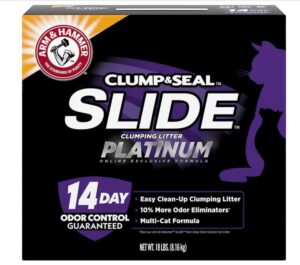
You can learn more about the product here.
Non-Clumping Clay Litter
This type doesn’t form clumps when wet. Instead, it absorbs the liquid and requires more frequent complete litter box cleaning.
Pros
- Odor Control: Non-clumping clay litter is often effective at absorbing and controlling odors associated with cat urine. Some non-clumping litters may contain additives like baking soda or charcoal to help neutralize odors.
- Absorbency: Non-clumping clay litter has high absorbency, meaning it can absorb large volumes of urine without saturating quickly. This can be beneficial if you have multiple cats or if you prefer less frequent litter box maintenance.
- Cost-Effective: Non-clumping clay litter is generally more affordable compared to clumping litter options. If you’re on a budget, non-clumping clay litter can be a cost-effective choice.
Cons
- Cleaning Difficulty: Since non-clumping clay litter does not form clumps urine may accumulate at the bottom of the litter box, requiring more frequent complete litter box changes.
- Dust: Non-clumping clay litter can generate dust particles when poured or disturbed, which may be a concern for cats with respiratory sensitivities or for households with allergies. Choosing low-dust options can help minimize this issue.
- Tracking: Non-clumping clay litter particles can be easily tracked outside the litter box due to their larger granules. Placing a mat or rug near the litter box can help reduce tracking.
- Environmental Impact: Non-clumping clay litter is often made from natural clay resources that require mining. The extraction process can have environmental consequences, including habitat disruption and soil degradation.
- Weight: Non-clumping clay litter tends to be heavier than clumping litter due to its higher density. This can make it more challenging to carry and pour, especially for individuals with physical limitations.
If you are looking for good not clamping kitty litter, Purina Tidy Cats Non Clumping Cat Litter could be a good choice.
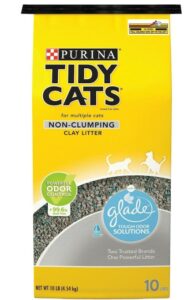
You can check the current pricing here.
Silica Crystals Litter
Silica crystals litter for cats, also known as silica gel litter, is a type of cat litter that is made from silica dioxide sand, oxygen, and water. It consists of porous gel-like crystals that are designed to absorb moisture and control odors in the litter box.
Pros
- Absorbency: Silica crystals have excellent absorbency and can hold a significant amount of liquid. They can effectively trap and absorb cat urine, keeping the litter box dry and minimizing odors.
- Odor Control: Silica crystals litter is known for its superior odor control properties. The crystals can help neutralize and reduce unpleasant smells associated with cat waste.
- Low Dust: Silica crystal litter is generally low in dust, making it a good choice for cats and owners who are sensitive to dust or have respiratory issues. The low dust content helps maintain a cleaner and healthier environment.
- Long Lasting: Due to their high absorbency, silica crystals litter tends to last longer compared to other types of litter. It may require less frequent litter box changes, resulting in cost savings and convenience.
- Lightweight: Silica crystals are lightweight compared to traditional clay litter, making it easier to handle and pour. This can be beneficial for individuals with physical limitations or those who prefer a lighter litter option.
Cons
- Stirring Required: Silica crystal litter needs to be stirred regularly to maintain its effectiveness. Stirring helps redistribute the crystals and prevents them from saturating in one area. Without proper stirring, the litter may not work optimally.
- Price: Silica crystal litter can be relatively more expensive compared to traditional clay litter options. The higher cost may be a consideration for budget-conscious cat owners.
- Litter Tracking: The larger granules of silica crystals litter can be easily tracked outside the litter box, leading to litter scatter. Placing a mat or using a litter box with high sides can help minimize tracking.
- Poo Odor Coverage: While silica crystals litter is effective at controlling urine odors, it may not be as effective in covering up feces odor. Additional measures such as timely removal of solid waste may be necessary.
- Premature Breakdown: In some cases, silica gel crystals may break down prematurely, creating dust particles. This can happen when the litter is not stirred regularly or when it reaches its saturation point.
If you are looking to try crystal litter, PetSafe ScoopFree Premium Blue Crystal Litter is affordable option.
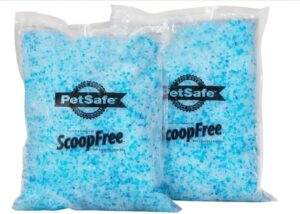
You can check the current pricing here.
Dust-Free Litter
Dust-free litter for cats is designed to minimize the amount of dust produced when pouring, scooping, or sifting through the litter. This type of litter is beneficial for both cats and their owners, as it reduces the potential for respiratory irritation caused by dust particles.
Pros
- Reduced Dust: Dust-free cat litter significantly reduces the amount of airborne dust particles, making it more comfortable for both cats and humans. This is particularly beneficial for cats with respiratory sensitivities, allergies, or asthma, as it helps promote better air quality in the home.
- Respiratory Health: By minimizing dust, dust-free litter helps protect the respiratory health of cats and their owners. It decreases the risk of respiratory problems, such as coughing, sneezing, and breathing difficulties, that can be triggered by dust inhalation.
- Easy Cleanup: Dust-free litter tends to be less messy during cleanup. Since there is less dust, it reduces the likelihood of tracking and spreading litter particles around the house. This can make litter box maintenance more convenient and minimize the need for extensive cleaning.
- Cat Comfort: Cats may prefer dust-free litter because it feels softer and smoother on their paws. Some cats can be sensitive to the texture of litter and may avoid using a litter box with dusty litter. Dust-free options can help create a more appealing litter box environment for finicky cats.
Cons
- Limited Options: Dust-free cat litter may have fewer options available compared to traditional litters.
- Clumping Ability: Some dust-free litters may have reduced clumping ability compared to traditional clumping litters. While they still offer some clumping, it may not be as firm or effective, making scooping and cleaning slightly more challenging.
- Cost: Dust-free cat litter can be relatively more expensive than regular litter. The manufacturing processes involved in reducing dust can contribute to higher production costs, resulting in a higher price point for these specialized litters.
- Tracking: Although dust-free litter minimizes airborne dust, it may still track outside the litter box. Tracking occurs when litter particles stick to the cat’s paws and are carried out of the box, potentially spreading throughout the house. Regular cleaning and using litter mats can help mitigate tracking issues.
A good dust-free litter is Dr. Elsey’s Premium Clumping Cat Litter – Ultra – 99.9% Dust-Free.
An affordable and effective option. You can see more here.
Non-Tracking Litter
This type of litter is designed to have larger and heavier granules or particles that are less likely to stick to a cat’s paws and be carried outside of the litter box.
Pros
- Reduced Mess: Non-tracking litter helps minimize the mess associated with litter tracking. The larger and heavier granules are less likely to be scattered or tracked outside of the litter box, keeping your home cleaner and reducing the need for frequent cleanups.
- Easy Cleanup: Since non-tracking litter tends to stay within the litter box, cleaning and maintaining the litter box becomes easier. You’ll spend less time sweeping or vacuuming scattered litter and more time focusing on other aspects of cat care.
- Improved Air Quality: Non-tracking litter can help improve the air quality in your home by reducing the amount of airborne litter dust. This is particularly beneficial for cats and humans with respiratory sensitivities or allergies, as it minimizes the inhalation of dust particles.
- Cat Comfort: The larger and smoother granules of non-tracking litter can provide a more comfortable texture for your cat’s paws. Some cats may prefer this type of litter, especially if they are sensitive to the texture of the finer or stickier litter.
Cons
- Limited Options: Non-tracking cat litter may have fewer options available compared to traditional litters.
- Clumping Ability: Non-tracking litter may have different clumping abilities compared to traditional clumping litter. While some non-tracking litters still clump well, others may not form as firm or tight clumps, making scooping and cleaning slightly more challenging.
- Price: Non-tracking cat litter may be relatively more expensive compared to regular litters. The manufacturing processes involved in creating non-tracking properties can contribute to higher production costs, resulting in a higher price point for these specialized litters.
- Tracking Reduction, Not Elimination: Despite being labeled as non-tracking, it’s important to note that no litter is completely immune to tracking. While non-tracking litter reduces tracking to a great extent, there may still be some minimal tracking outside the litter box.
Our pick is Dr. Elsey’s Premium Clumping Cat Litter – Clean Tracks.
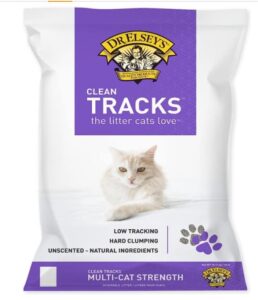
You can learn more here.
Biodegradable Litter
Biodegradable litter for cats refers to a type of cat litter that is designed to be more environmentally friendly and sustainable compared to traditional clay or silica-based litters.
These litters are typically made from natural, renewable, and biodegradable materials such as wood, paper, corn, wheat, walnut shells, and more.
Here are different types of biodegradable cat litter:
- Wood-Based Cat Litter
- Pine-Based Cat Litter
- Tofu-Based Cat Litter
- Paper-Based Cat Litter
- Corn-Based Cat Litter
- Wheat-Based Cat Litter
- Walnut Shell-Based Cat Litter
Wood-Based Cat Litter
Wood-based cat litter is a type of cat litter that is made from wood materials, usually in the form of pellets or granules, sawdust, reclaimed wood, or other wood materials. It is an alternative to traditional clay-based litter and has gained popularity due to its eco-friendly properties and other advantages.
Pros
- Natural and Eco-Friendly: Wood-based cat litter is typically made from recycled or sustainable wood materials, making it a more environmentally friendly option compared to clay litters. It reduces the need for mining or extracting natural resources.
- Absorbency: Wood pellets or granules have good absorbency properties, effectively trapping urine and controlling odors. They can absorb moisture and liquids, helping to keep the litter box drier and fresher for longer periods.
- Biodegradable: Wood-based cat litter is biodegradable, meaning it can break down naturally over time. It can be composted or safely disposed of in an eco-friendly manner, reducing waste and landfill impact.
- Dust-Free: Wood pellets or granules tend to produce less dust compared to clay litters, creating a cleaner and healthier environment for both cats and their owners. This can be particularly beneficial for cats with respiratory sensitivities or allergies.
- Reduced Tracking: Wood-based litter generally has larger and heavier particles, which are less likely to be tracked outside the litter box by cats. This can help minimize litter mess and keep your home cleaner.
Cons
- No Clumping: Unlike some clay-based litters, wood-based litter typically does not clump when wet. This can make scooping and cleaning the litter box slightly more challenging, as the wet litter may break apart or disintegrate.
- Tracking: While wood-based litter reduces tracking compared to clay litter, some tracking may still occur, especially if the pellets or granules stick to a cat’s paws. Regular sweeping or using a litter mat can help minimize tracking.
- Odor Control: While wood-based litters have natural odor control properties, they may not be as effective as some clumping litters with added odor-fighting agents. However, regular scooping and proper litter box maintenance can help mitigate any odor issues.
- Availability and Cost: Wood-based cat litter may not be as widely available as traditional clay litters, and it can sometimes be more expensive. However, the cost can vary depending on the brand and specific type of wood-based litter chosen.
We like the ökocat Less Mess Natural Wood Clumping Cat Litter.
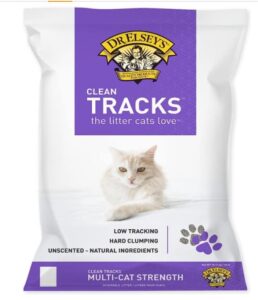
You can browse and learn more here.
Pine-Based Cat Litter
Pine-based cat litter is a type of cat litter that is made from pine sawdust or compressed pine pellets.
Pros
- Non-Toxic and Natural: Pine-based cat litter is typically non-toxic and made from all-natural pine sawdust or pellets. It does not contain additives or chemicals that could be harmful to cats or humans, making it a safer option.
- Eco-Friendly: Pine litter is often considered more environmentally friendly compared to traditional clay litters. It is biodegradable and can be composted or disposed of in an environmentally responsible manner.
- Odor Control: Pine litter has natural odor-controlling properties. The pine scent helps to mask unpleasant odors, keeping the litter box area smelling fresher.
- Low Dust: Pine-based cat litter tends to produce less dust compared to clay-based litter. This can be beneficial for cats and owners who are sensitive to dust or have respiratory issues.
- Gentle on Cat’s Paws: The texture of pine litter is generally softer and less abrasive than clay litter. This can be more comfortable for cats to walk on and can be particularly beneficial for cats with sensitive paws.
Cons
- Tracking: Pine pellets or sawdust may have a tendency to track outside the litter box, similar to other litters with smaller particles. Using litter mats or other containment systems can help minimize tracking.
- Less Effective for Feces Odor: While pine litter is often effective at controlling urine odors, it may be less effective at masking feces odors. This could require more frequent scooping and cleaning to maintain a fresh-smelling litter box.
- Transition Challenges: Some cats may require a transition period to get used to pine litter, especially if they are accustomed to a different type of litter. Cats with strong preferences or aversions to certain textures may be resistant to using pine-based litter.
- Availability and Cost: Pine-based cat litter may be less widely available compared to more mainstream options like clay litter. It can also be relatively more expensive, depending on the brand and packaging.
- Strong scent
We like Feline Pine Original Cat Litter
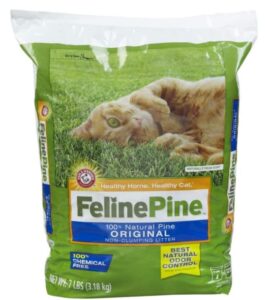
You can find this or similar pine-based litters here.
Tofu-Based Cat Litter
Tofu-based cat litter is a relatively new and innovative alternative to traditional cat litters. It is made from the food-grade pulp of soybeans, which gives it the name “tofu” as it is the same material used to make tofu that we eat. Tofu cat litter is considered a non-toxic and 100% natural option.
Pros
- Natural and Non-Toxic: Tofu cat litter is made from natural ingredients and does not contain harmful chemicals or additives. It provides a safer and healthier option for both cats and humans.
- Biodegradable: Tofu cat litter is biodegradable, meaning it can break down naturally over time, reducing its impact on the environment.
- Good Odor Control: Tofu cat litter is known to have good odor control properties, helping to keep your home smelling fresh.
- Dust-Free: Tofu cat litter tends to produce less dust compared to some other types of cat litter, making it a better choice for cats and people with respiratory sensitivities.
- Clumping Ability: Many tofu cat litters have clumping capabilities, allowing for easier scooping and maintenance of the litter box.
Cons
- Availability: Tofu-based cat litter may not be as widely available as traditional cat litter, so it could be more challenging to find in some areas.
- Tracking: Some users have reported that tofu cat litter can track more compared to other types of litter, potentially leading to litter particles being scattered around the house.
- Price: Tofu cat litter can be more expensive compared to conventional clay litter.
A good and affordable option is PATLOOL Clumping Cat Litter, and Tofu Cat Litter.
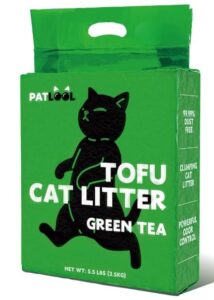
You can find this or similar tofu-based litter here.
Paper-Based Cat Litter
Paper-based cat litter is a type of cat litter that is made from recycled paper materials or paper pulp.
Pros
- Eco-Friendly: Paper-based cat litter is made from recycled paper materials, reducing the demand for new resources and promoting environmental sustainability. It helps reduce waste and is biodegradable, making it a more eco-friendly choice.
- Low Tracking: Paper pellets or granules are generally larger and heavier than clay particles, which reduces the likelihood of them being tracked outside the litter box. This can help keep your home cleaner and minimize the mess associated with litter tracking.
- Dust-Free: Paper cat litter is often dust-free or produces minimal dust compared to clay litters. This is beneficial for both cats and owners, especially for cats with respiratory sensitivities or allergies, as it creates a healthier environment.
- Absorbency: Paper-based litter can have good absorbency properties, effectively soaking up moisture and controlling odors. They can help keep the litter box drier and fresher for longer periods, contributing to a more pleasant experience for both cats and owners.
- Variety of Types and Textures: Paper cat litter is available in various types and textures, allowing cat owners to choose the one that best suits their preferences and their cats’ preferences. Options include pellet-style litter, shredded paper litter, or paper-based litter combined with other materials.
Cons
- Odor Control: While paper-based cat litter can help control odors to some extent, it may not be as effective as certain clumping litters or litters with added odor-fighting agents. Regular scooping and litter box maintenance are important to manage odor issues effectively.
- Cost: Paper cat litter can be more expensive than traditional clay litter. The cost can vary depending on the brand and specific type of paper-based litter chosen. However, it’s worth considering the long-term environmental benefits and the potential health advantages for your cat.
- Availability: Paper-based cat litter may not be as widely available as clay litter in some regions. However, with increasing awareness and demand for eco-friendly options, the availability of paper-based litter is expanding.
- Cat Preference: Not all cats may readily accept or prefer paper-based litter due to differences in texture and scent. Some cats may take time to adjust to the new litter and may require a gradual transition or alternative litter options.
If you are looking to ty paper-based litter, Fresh News Recycled Paper, Original Pellet Cat Litter is a good option.
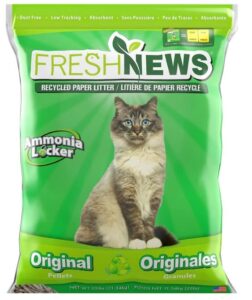
You can find it here.
Corn-Based Cat Litter
Corn-based cat litter is a type of cat litter that is primarily made from corn or corn-based ingredients, corn kernels or corn by-products.
Pros
- Natural and Biodegradable: Corn-based cat litter is made from renewable and biodegradable materials, which makes it an environmentally-friendly choice. It is often considered a more sustainable option compared to clay litter.
- Low Dust: Corn-based litters are generally low in dust, making them a suitable option for cats and owners who are sensitive to dust or have respiratory issues. The reduced dust can help create a cleaner and healthier litter box environment.
- Good Odor Control: Corn-based litters often have natural odor-controlling properties. The corn particles can help absorb and neutralize odors, keeping the litter box fresher for longer periods. Some corn-based litters may also contain added natural or activated carbon ingredients for enhanced odor control.
- Clumping Ability: Many corn-based litters have clumping properties, which means they form solid clumps when they come into contact with moisture. This makes it easier to scoop and remove soiled litter, contributing to easier litter box maintenance.
- Flushable: Some corn-based litters are designed to be flushable, allowing for convenient disposal in toilets. This can be beneficial for cat owners who prefer a hassle-free method of waste disposal.
Cons
- Tracking: Corn-based litter, particularly those with smaller particle sizes, can have a tendency to track outside the litter box. This may result in more frequent cleanups and a need for additional litter mats or containment systems to minimize tracking.
- Attraction to Bugs: Corn-based litter, due to its organic nature, may attract insects or bugs if not stored properly. It’s important to keep the litter stored in airtight containers to prevent infestations.
- Potential Aflatoxin Contamination: While rare, there have been concerns about aflatoxin mold growth in corn-based cat litter. Aflatoxins can be harmful to cats if ingested. It’s crucial to choose reputable brands that follow strict quality control measures to minimize the risk of aflatoxin contamination.
- Price: Corn-based litter may be more expensive compared to some traditional clay litters. The cost can vary depending on the brand, quality, and specific features of the litter.
A great corn based litter is Nature’s Miracle Premium Clumping Corn Cob Litter
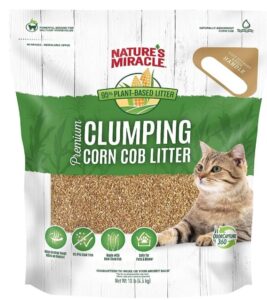
You can find this, or similar options here.
Wheat-Based Cat Litter
Wheat-based cat litter is a type of cat litter that is primarily made from wheat or wheat-based ingredients, wheat by-products, or ground wheat.
Pros
- Natural and Biodegradable: Wheat-based cat litter is made from renewable and biodegradable materials, making it an eco-friendly choice. It is often considered a more sustainable option compared to clay litter.
- Low Dust: Wheat-based litters are generally low in dust, which makes them suitable for cats and owners who are sensitive to dust or have respiratory issues. The reduced dust can contribute to a cleaner and healthier litter box environment.
- Clumping Ability: Many wheat-based litters have clumping properties, similar to clay litters. This means that they form solid clumps when they come into contact with moisture, making it easier to scoop and remove soiled litter.
- Odor Control: Wheat-based litters often have natural odor-controlling properties. They can help absorb and neutralize odors, keeping the litter box fresher for longer periods.
- Flushable: Some wheat-based litters are designed to be flushable, allowing for convenient disposal in toilets. This can be beneficial for cat owners who prefer a hassle-free method of waste disposal.
Cons
- Tracking: Wheat-based litter, especially those with smaller particle sizes, may have a tendency to track outside the litter box. This may result in more frequent cleanups and a need for additional litter mats or containment systems to minimize tracking.
- Attraction to Bugs: Wheat-based litter, due to its organic nature, may attract insects or bugs if not stored properly. It’s important to keep the litter stored in airtight containers to prevent infestations.
- Potential Allergies: Some cats may be allergic or sensitive to wheat. If your cat has known allergies or sensitivities, it’s important to monitor their reaction when switching to a wheat-based litter.
- Price: Wheat-based litter may be more expensive compared to traditional clay litter. The cost can vary depending on the brand, quality, and specific features of the litter.
Our pick is sWheat Scoop Wheat-Based Natural Cat Litter.
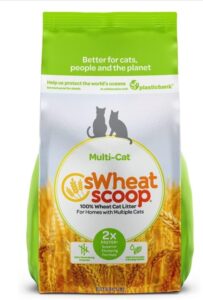
If you are looking to learn more, you can browse here.
Walnut Shell-Based Cat Litter
Walnut shell-based cat litter is a type of cat litter that is primarily made from crushed walnut shells.
Pros
- Environmentally Friendly: Walnut shell-based cat litter is considered an eco-friendly option. The walnut shells used to make the litter are biodegradable and a byproduct of the food industry, reducing waste.
- Odor Control: Walnut shell litter has natural odor-absorbing properties. The compounds present in walnut shells help to absorb and neutralize urine and fecal odors, keeping the litter box and your home fresher.
- Virtually Dust-Free: Unlike clay-based litters that can produce dust particles, walnut shell litter is generally low in dust. This can be beneficial for both cats and owners who are sensitive to dust or have respiratory issues.
- Gentle on Cat’s Paws: Walnut shell litter has a texture that is similar to sand or soil, providing a natural and comfortable feeling for cats when they dig in the litter box.
- Clumping Ability: Many walnut shell-based litters have clumping properties, similar to clay litters. This allows for easier scooping and removal of soiled litter, contributing to a cleaner litter box.
Cons
- Potential Allergies: There is a risk of allergic reactions in humans or cats with nut allergies when using walnut shell litter. If you or your cat have known nut allergies, it’s important to test a small amount of the litter and monitor for any irritation or allergic symptoms.
- Tracking: Walnut shell litter may have a tendency to track outside the litter box, similar to other litters with smaller particle sizes. Using litter mats or other containment systems can help minimize tracking.
- Availability: Walnut shell-based cat litter may not be as widely available in pet stores compared to more mainstream options like clay litter. However, availability is increasing as its popularity grows, and it can often be conveniently purchased online.
Here is our favourite walnut-based litter: Naturally Fresh Cat Litter.
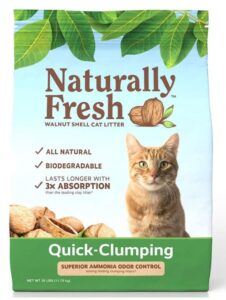
You can browse and learn more here.
Does the type of cat litter matter?
Yes. Cats have individual preferences when it comes to litter. The type of cat litter has an impact on your cat’s comfort, litter box usage, and overall cleanliness. Different cats may have different preferences when it comes to litter, and finding the right type can help ensure that your cat consistently uses the litter box.
Which type of litter is best for cats?
Cats generally prefer fine unscented particle litters over pellet and crystal-type ones. This preference can be attributed to their natural instincts as desert-dwelling animals that bury their waste in the sand.
Cats have a more sensitive sense of smell than humans, unscented litters help create a more natural and pleasant environment for your cat’s sensitive nose.
How to choose a cat litter
When deciding on a new litter purchase,
- Fast and Easy Cleanup: Opt for a litter that forms solid clumps when it comes into contact with liquid waste. Clumping litter makes it easier to scoop out soiled litter, keeping the litter box cleaner and minimizing odor.
- Effective Odor Control: Look for a cat litter that specifically targets odor control. Some litters contain activated charcoal or natural odor-absorbing ingredients to neutralize unpleasant smells
- Low Dust Formula: Choose a cat litter with low dust production to keep your home environment clean and prevent respiratory issues. Consider litters that advertise low dust or dust-free formulas.
- Reduced Tracking: Choose an anti-tracking cat litter or utilize anti-tracking litter mats to prevent litter from being scattered around the house. Look for a litter specifically designed to minimize tracking, or use a litter mat that effectively traps litter particles and keeps them contained within the designated area.
- Material and Texture: Cat litters come in various materials such as clay, crystal, wood pellets, or recycled paper. Cats have different preferences, so observe your cat’s reaction to different textures and materials.
- Multi-Cat or Single-Cat Formulas: If you have multiple cats, look for a cat litter specifically designed for multi-cat households. These litters often have enhanced odor control and better clumping properties to handle higher usage levels.
- Tracking Prevention: Consider using an anti-tracking litter or placing litter mats around the litter box to minimize litter tracking throughout your home.
The truth is, your cat picks the litter 🙂
You can try different options and opt for the one that your cat enjoys the most.
My Senior Paws is a participant in the Amazon Services LLC Associates Program, an affiliate advertising program designed to provide a means for sites to earn advertising fees by advertising and linking to Amazon.com. We also participate in other affiliate programs which compensate us for referring traffic.
